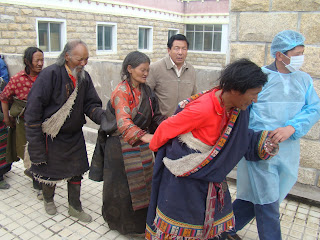Dolma Tchiki works for Seva Canada, in their Tibet Office, managing eye care projects across the Tibet Autonomous Region.

The Tibetan region is different from the rest of china, in terms of climate, culture and religion, categorised as 'high plateau'- with very distinct weather patterns. I
t is Very cold, with a lot of snow on the mountains and elsewhere, with moderate summers. All Tibetans practice Buddhism, so there are many monasteries. The main population is divided into two groups: farmers & nomads.
Tibet is considered to have the highest prevalence of cataract in China. A regional eye care assessment was carried out by Seva in 2002, showing that blindness 1.39%, while 50.7% of this was due to cataract.

In the Tibet Autonomous Region, Seva provides around 70% of eye care services.
Seva has 15 years' eye care experience in Tibet, and the eye care assessment helped tremendously with VISION 2020 regional planning by various govt agencies and other NGOs. Since the assessment in 2002, Seva has also been able to do very solid planning for its eye health services. Seva Tibet works with 8 govt hospitals, and this is different from many eye care organisations who work only with private clinics. The experience has been very positive, and I was pleasantly surprised to find that we have received a lot of support, particularly from the regional government. I am very optimistic about the future of eye health care in the Tibet Region, especially since two years ago when the Chinese MoH increased budgetary support for cataract patients in Tibet. This money will help us to develop hospital infrastructure, and also to reduce cost of this essentia
l surgery to the patients themselves.

Seva developed a suitable, comprehensive eye care model for Tibet:
- annual eye camps in the Regions
- helping govt hospitals to build capacity
- [previously to Seva's intervention foreign volunteers were needed to provide eye care services because there were no local doctors with necessary training and competence] now, local doctors have gained confidence with the technique, and all cataract surgeries are now done by Tibetan practitioners.
Building local capacity is one of Seva's priorities. We train surgeons and other personnel. Although fully qualified ophthalmologists, many Tibetan staff did not have the skills even to perform cataract surgery. We initially sent doctors to China for clinical training, and later to Lumbini Eye Centre in Nepal for surgical training. Lubmini is dealing with a much higher volume of patients than anywhere in China, so it presents an excellent opportunity for ophthalmologists to get experience in a variety of surgical techniques.
Having returned to Tibet after 4 years' studying economics in the USA, I was overwhelmed by Seva's dedication to elimination of blindness, and decided to change my own direction from economics to health programming. In my role here, I document 'human interest' stories, which can be used to illustrate to donors the tremendous benefit of their contributions, however small.
An example of a case which touched my heart was when little girl of 7 years was brought to the clinic. She was very pretty girl, but I noticed that she was not very animated - she just sat on her mother's lap, very still and rigid. I asked the mother about her daughter, and she said that her girl had been blind for two years. Before that, she had been very active, with a bright personality, but had become increasingly withdrawn ever since. When I tried to engage the girl in conversation, she was very shy and nervous of being touched, or interacting in any way with a stranger. Ten minutes before she went into the operating theatre, I realised that she would not let go of her mother. It was so sad to see this beautiful girl, who should have been running around a schoolyard with her peers, but instead was as withdrawn and reserved as an eighty-year-old woman...
I visited her the next day, and was taking photos of the little girl and other patients. She was fascinated by the camera, and by everything around her - running around the room and examining everything she found. It was like looking at a different child! This transformation was almost instant - in just one day her personality, and her life chances, had utterly changed. This simple piece of surgery had opened up her world.
Seva Canada is very grateful to be part of VISION 2020. It allows us to exchange information and experiences with other eye health organisations, some of which can benefit our own work, while we can help others by sharing what Seva has learned in 15 years working in Tibet. I was lucky enough to attend a workshop on the subject of Gender and Blindness held by Seva's partner agency in Tanzania KCCO, where I presented some of my experiences here, and to learn from other programme professionals. It has been a real 'eye opener' for me! Watching other programmes from other countries teaches me tremendously - there are many more ways to reach female patients, than we have used in Tibet. Here, in terms of hospital-based care the take-up is dominated by men and boys, while in our eye camps more female than male patients attend for treatment. This disparity is largely due to difficulties in travel and transport. In a huge country, there are only 3m people, so density is very low, and it is difficult for women in particular to cover those sorts of distances alone.




